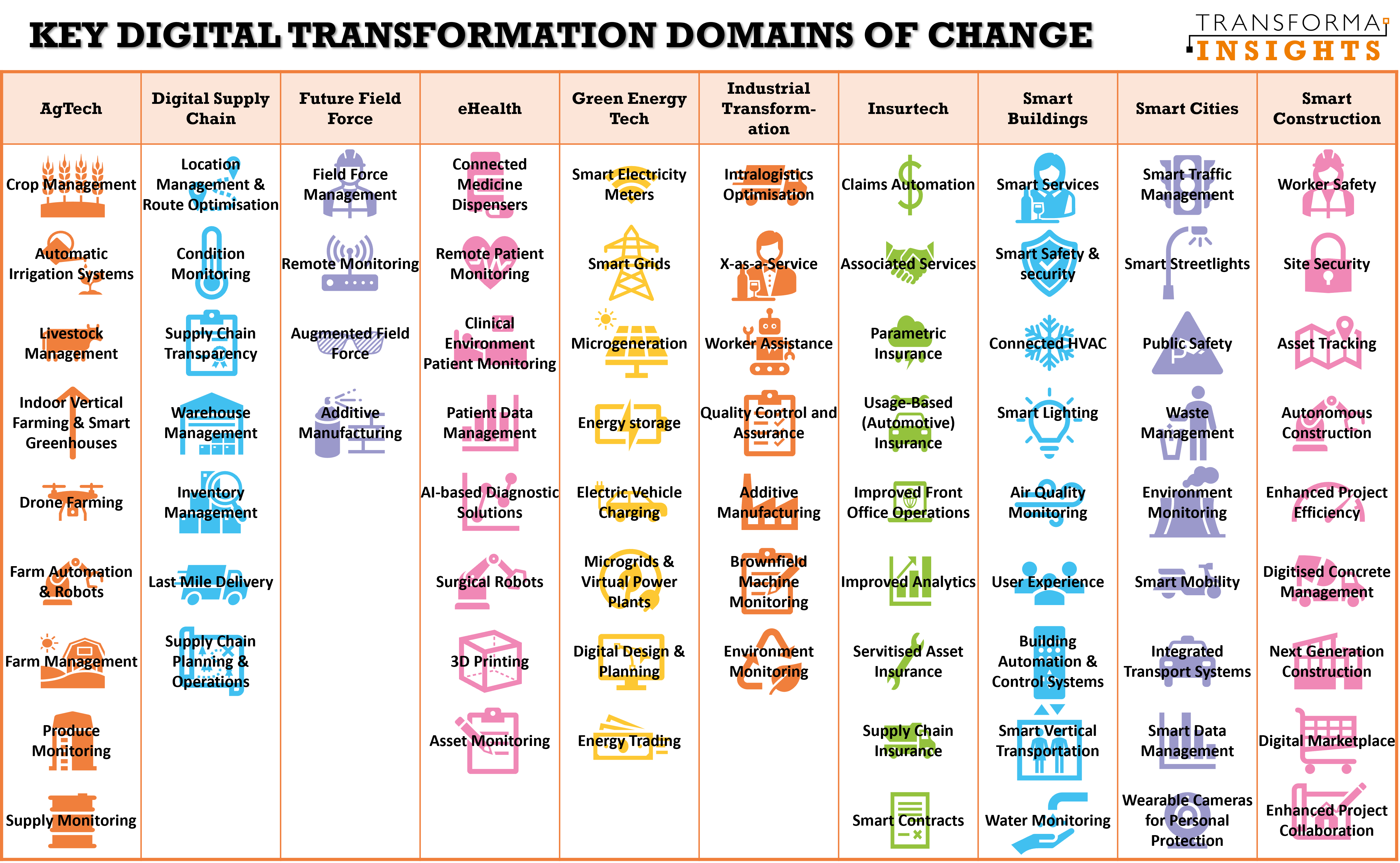The technology industry is alight with talk of digitally transformative technologies including the Internet of Things (IoT), Artificial Intelligence (AI), data sharing, distributed ledger, 5G connectivity and more. But, as always, it is only when end-users deploy solutions that leverage these technologies that digitally transformed industries will materialise. So, what will be the real-world impact of new emerging technologies?
Transforma Insights has undertaken extensive research to identify the key ‘Domains of Change’ in end-user adopter segments, enabled by a range of digitally transformative technologies. Our findings have been summarised in a series of Sector Reports available via dedicated Sector Pages. The Sector Pages also provide links to other reports that are specifically relevant to the sector in question (note: all of our reports are also available via our Reports & Insights page). The sectors and identified Domains of Change are illustrated below. Each sector has a matching Sector Page, other than Future Field Force and Smart Buildings (which are work in progress). AutoTech will follow soon.

The purpose of our Sector Reports is two-fold. Firstly, from the perspective of practitioners in the sectors, the reports highlight new and emerging aspects of change that can be expected to impact the sector in the next few years. Secondly, from the perspective of potential vendors to the sectors, they highlight key emerging areas of opportunity to sell new products, services, and solutions into the sectors. Our analysis of the key technologies that enable each of the identified areas of digital transformation will help vendors of horizontal (technology-specific) capabilities to identify the contexts in which they may be able to secure new business from the profiled sectors.
The reports include detailed analysis of each Domain of Change, together with case studies and profiles of key vendors.
Of all emerging technologies IoT will probably be the most impactful, extending the reach of technology-enabled change into the real world. A quick glance through the domains of change listed above reveals very few that do not in some way leverage IoT. Changes enabled by IoT range from Automatic Irrigation Systems in agriculture to Parametric Insurance and from Warehouse Monitoring to Digitised Concrete Management in construction.
The deployment of many of these IoT solutions is enabled by, or at least accelerated by, the emergence of new wireless connectivity technologies such as Low Power Wide Area (LPWA) and 5G. LPWA technologies in particular have the potential to extend technical solutions further into harder-to-reach locations by virtue of their ability to combine low costs with wide area coverage and low power consumption (and so correspondingly long battery life). These technologies are a perfect fit for many applications such as Crop Monitoring and Environment Monitoring in smart cities.
Artificial Intelligence (AI) also features in a significant majority of the digitally transformative domains of change as illustrated above, often adding a next level of benefit layered on top of whatever can be achieved with IoT alone. The benefits associated with AI tend to fall into four main areas, including:
AI can, of course, be deployed independently of IoT, for instance in the context of Intelligent Recruitment & HR, but such opportunities are far more incremental in nature, and less transformational than the solution areas that we have identified as major domains of change.
Other technologies make relatively fleeting appearances. Distributed ledger, for instance, finds a potential role supporting X-aaS (servitisation) for manufacturers, Supply Chain Transparency, Patient Data Management for healthcare provider networks (particularly in the USA), and Servitised Asset Insurance, Supply Chain Insurance and Smart Contracts in the insurance industry. Additive Manufacturing (or 3D-Printing) is limited essentially to the manufacture of medical implants (particularly dental), niche manufacturing contexts and niche field force applications (so that spare parts can be manufactured where and when they are needed). Additive manufacturing techniques have also been applied to house building, wherein buildings can be built up with extruded concrete.
Applications associated with Autonomous Robotic Systems in particular are very diverse, ranging from exoskeletons that promote worker safety in construction contexts (and allow older workers to continue working for longer) to Surgical Robots and from Worker Assistance in factories to Livestock Management in Agriculture.
Data Sharing techniques are critical in the context of Farm Management, Enhanced Project Management and Asset Tracking in construction contexts, and many solution types in healthcare, smart cities, and supply chains.
As ever, digital transformation is not ‘all about the technology’. The domains of change discussed in this blog, and in more detail in the associated reports, all combine new technologies in different ways and to do different things. All of the identified domains of change exist by virtue of the fact that they address constraints associated with current-day approaches, or capitalise on opportunities to deliver better outcomes, typically for less cost and with enhanced sustainability footprints.